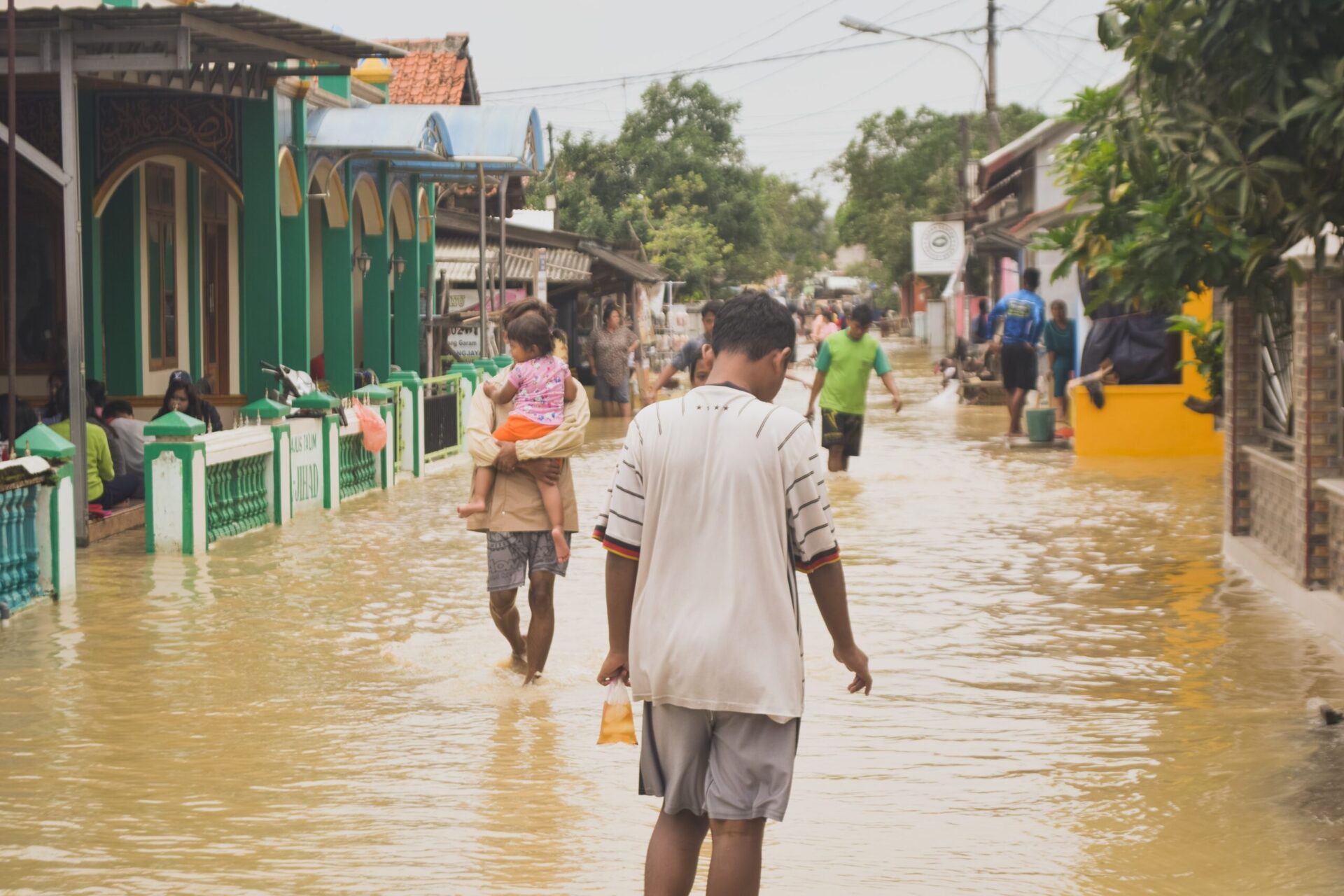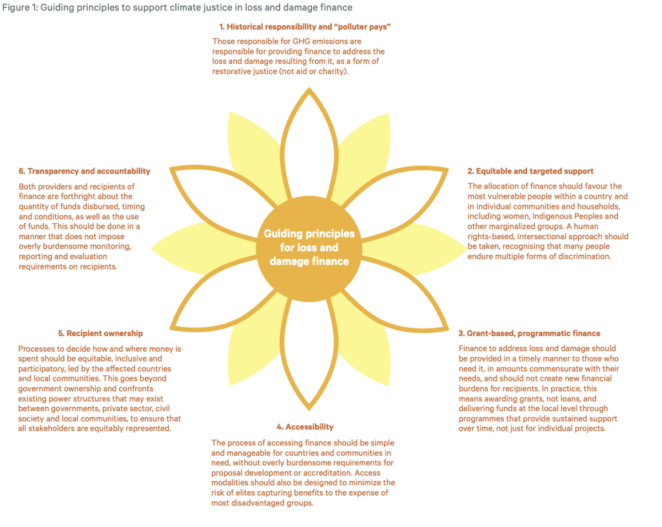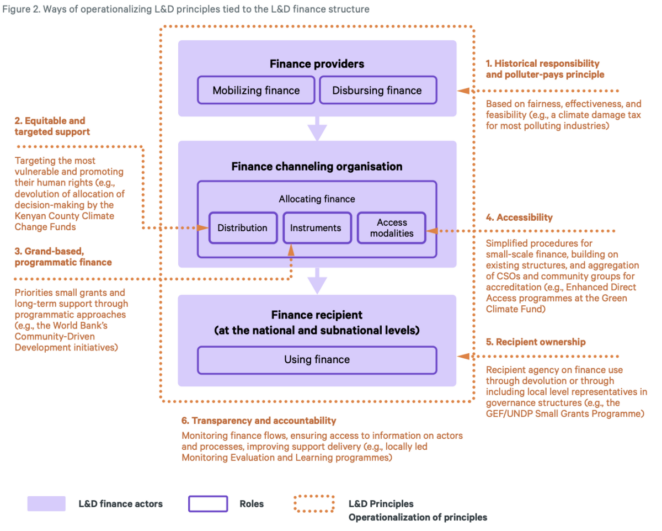Operationalizing Finance for Loss and Damage: from Principles to Modalities

Introduction
Vulnerable countries and communities are already facing loss and damage resulting from climate impacts, and urgently need financial support to recover and rebuild livelihoods and infrastructure. Despite increasing demands, however, finance for addressing loss and damage has been largely absent and falls far short of the scale of needs. A number of gaps also exist within the existing climate finance architecture that make it unsuitable for addressing loss and damage.
This report aims to feed into ongoing negotiations and discussions on loss and damage finance by exploring different options for how it can be operationalized.
This weADAPT article is an abridged version of the original text, which can be downloaded from the right-hand column. Please access the original text for more detail, research purposes, full references, or to quote text.
Methods
This report builds on the work presented in Shawoo et al., 2021.First, wereview the existing literatureonclimate justice andeffectivenessof climate finance, development and humanitarian assistanceto set out key principles for loss and damage finance that are grounded in climate justice.The literature review also collects learnings from past and present funding initiatives on the application of these principles in the current climate finance architecture. Secondly, we draw on interviews with key stakeholders toidentify options for how those principles can be operationalized within a potential global loss and damage finance facility, including what structures and modalities need to be put in place at the global, national and sub-national levelto ensure that finance for loss and damage reaches the most vulnerable populations to climate impacts, and meets their needs and expectations.Note that some stakeholder groups have not yet been captured in this report, and that these gaps are filled by a review of literature and of some UN meetings proceedings. More interviews will be conducted in the year following the publication of this report.

Key Findings and Recommendations
We find that the following principles should underpin how loss and damage finance is operationalized: historical responsibility and the “polluter pays” principle; equitable and targeted support (including ensuring gender equality and protecting human rights); grant-based and programmatic finance; accessibility; recipient ownership; and transparency and accountability.In practice, it meansthat modalities for loss and damage finance should be designed to centre the needs and priorities of vulnerable communities. This includes giving those communities significant autonomy and decision-making power over how finance is utilized in accordance with their needs. Small grants and unconditional cash transfers, as opposed to loans or project-based finance, are also likely to be more accessible for recipients and effective in reaching affected communities. Other key findings include:
- Climate finance is currently largely inaccessible for recipient countries and communities due to stringent proposal and accreditation requirements and long lag times in delivery. Negotiations on loss and damage finance at COP27 should prioritize simplified and enhanced direct access procedures that deliver funding directly to communities and marginalized groups.
- Our review of the literature suggests that loss and damage finance should take an intersectional approach that empowers vulnerable groups and puts them at the centre of decision-making. Figure 2 summarizes how the six principles identified through our literature review apply to different actors, and includes examples of how the principles can be operationalized.
- Loan-based and project-based finance often increases the debt burdens of recipient countries, is associated with burdensome reporting requirements, and often doesn’t reach the most vulnerable communities in need. Funders both within and outside the UNFCCC should prioritize small grants and unconditional cash transfers, which are likelier to reach disempowered and marginalized groups quickly.
- Climate finance is often associated with conditionalities and not distributed and utilized according the needs of recipients. Negotiations on loss and damage finance should ensure that recipients – particularly representatives of the most vulnerable and discriminated communities – are involved at all stages of decision-making and have a say on how finance is allocated and utilized. This could involve sitting on the board of a potential loss and damage finance facility at the global level, or devolving decision-making to the lowest levels.
- Transparency and accountability requirements are currently burdensome for recipient countries, and often reflect the priorities of finance providers rather than being accountable to affected communities. Funders and policy-makers should embed independent and participatory approaches to monitoring and evaluation in their structures and create accountability mechanisms that empower recipient communities.
- A loss and damage finance facility would take time to implement and has no guarantee of success, but has the advantage of offering a blank slate for modalities tailored to principles grounded in climate justice. A COP27 decision could include a phased approach of establishing a facility in the medium term and mobilizing finance through existing mechanisms in the immediate term. Subsequent sessions of the Glasgow Dialogue could be used to discuss the arrangements of the facility. In the interim, loss and damage finance could be mobilized bilaterally and through small-scale pilot programmes, such as through small grants under the Green Climate Fund.

Conclusions
Overall, both the literature and our interviews suggest that successful examples of just and effective climate finance delivery tend to be small-scale projects offering direct access at the community level. While many such models are still at a piloting stage, and we cannot conclude causality, we suggest that they might be a reasonable and effective way to deliver loss and damage finance, and offer an opportunity to try innovative approaches combined with inclusive learning processes. This could also catalyse the shift of climate finance altogether towards practices better aligned with climate justice.
Podcast
Listen to a podcast about the report. In this episode, Andrea Lindblom, Senior Communications Officer SEI HQ explores “Loss and Damage” – an umbrella term used in international climate negotiations under the UN Framework Convention on Climate Change (UNFCCC) and it looks set to be the defining issue for the upcoming UN climate change conference COP27. She speaks to Paul Chukwuma from the Loss and Damage Youth Coalition in Rwanda, and Zoha Shawoo and Inès Bakthaoui – both researchers at SEI who give their insights on what Loss and Damage is, and operationalizing its finance.
Suggested Citation:
Bakhtaoui, I., Shawoo, Z., Chhetri, R.P., Huq, S., Hossain, M.F., Iqbal, S.M.S., Lindsay, C., Mustapha, S., Naushin, S. Schaefer, L., Schalatek, L., Sircar, A., Tahsin, K.T., Thomas, A. & Wilkinson, E. (2022). Operationalizing Finance for Loss and Damage: From Principles to Modalities. SEI Report. Stockholm Environment Institute, Stockholm. https://doi.org/10.51414/sei2022.045
Related Reading:
Related resources
- Climate Risk Management Framework for India: Addressing Loss and Damage (L&D)
- Working Paper: Addressing Climate and Disaster Risk through Inclusive and Participatory Mechanisms
- A Range of Approaches to Address Loss and Damage from Climate Change Impacts in Bangladesh
- CDKN: Finance for Resilience Podcast
- Financing Smallholder Cocoa Rehabilitation in Ghana
- Financing from the Ground Up - Experiences in Adaptation Finance from Southeast Asia
- Climate finance: is it making a difference? A review of the effectiveness of multilateral climate funds
- Guidebook: Mobilising private sector finance for climate change adaptation
- A framework for mobilizing private finance and tracking the delivery of adaptation benefits
- Steering International Adaptation Finance Towards the Local Level
(0) Comments
There is no content